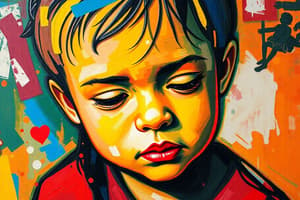Podcast
Questions and Answers
What is considered a form of child abuse that involves the use of physical force?
What is considered a form of child abuse that involves the use of physical force?
- Neglect
- Sexual abuse
- Emotional abuse
- Physical abuse (correct)
Which of the following is NOT an indicator of neglect?
Which of the following is NOT an indicator of neglect?
- Poor hygiene
- Frequent bruising (correct)
- Inadequate clothing
- Lack of medical care
What does emotional abuse in children adversely affect?
What does emotional abuse in children adversely affect?
- Social interactions
- Psychological development and self-esteem (correct)
- Physical growth
- Cognitive skills
Which of the following behaviors may indicate sexual abuse in a child?
Which of the following behaviors may indicate sexual abuse in a child?
Which statement best describes the responsibility of reporting suspected child abuse?
Which statement best describes the responsibility of reporting suspected child abuse?
What is one of the main purposes of legal frameworks concerning child abuse?
What is one of the main purposes of legal frameworks concerning child abuse?
Which of the following is a sign of emotional abuse in children?
Which of the following is a sign of emotional abuse in children?
What is a common misconception about reporting child abuse?
What is a common misconception about reporting child abuse?
What is a primary goal of child protection policies?
What is a primary goal of child protection policies?
Which of the following is a potential long-term effect of child abuse?
Which of the following is a potential long-term effect of child abuse?
What type of interventions are included in child protection systems?
What type of interventions are included in child protection systems?
Which of the following approaches is essential for preventing child abuse?
Which of the following approaches is essential for preventing child abuse?
What is the role of professionals in child protection?
What is the role of professionals in child protection?
Why is confidentiality important in child abuse investigations?
Why is confidentiality important in child abuse investigations?
What do mandatory reporting laws require professionals to do?
What do mandatory reporting laws require professionals to do?
Which of the following best describes a critical aspect of child protection interventions?
Which of the following best describes a critical aspect of child protection interventions?
Flashcards
What is Child Abuse?
What is Child Abuse?
Harmful acts directed at children that significantly impact their physical, emotional, and psychological well-being.
Types of Child Abuse
Types of Child Abuse
Child abuse includes: Physical abuse, Neglect, Emotional abuse, and Sexual abuse.
Physical Abuse
Physical Abuse
Intentional use of physical force that results in harm or injury to a child.
Neglect
Neglect
Signup and view all the flashcards
Emotional Abuse
Emotional Abuse
Signup and view all the flashcards
Sexual Abuse
Sexual Abuse
Signup and view all the flashcards
Reporting Child Abuse
Reporting Child Abuse
Signup and view all the flashcards
Legal Frameworks for Child Abuse
Legal Frameworks for Child Abuse
Signup and view all the flashcards
Child Protection Policies
Child Protection Policies
Signup and view all the flashcards
Impact of Child Abuse
Impact of Child Abuse
Signup and view all the flashcards
Interventions for Child Abuse
Interventions for Child Abuse
Signup and view all the flashcards
Prevention Strategies for Child Abuse
Prevention Strategies for Child Abuse
Signup and view all the flashcards
Mandatory Reporting
Mandatory Reporting
Signup and view all the flashcards
Professional's Role in Child Abuse
Professional's Role in Child Abuse
Signup and view all the flashcards
Confidentiality in Child Abuse
Confidentiality in Child Abuse
Signup and view all the flashcards
Information Sharing in Child Abuse
Information Sharing in Child Abuse
Signup and view all the flashcards
Study Notes
Definitions and Types of Child Abuse
- Child abuse encompasses a broad range of harmful acts directed at children, significantly impacting their physical, emotional, and psychological well-being.
- Abuse includes physical abuse, neglect, emotional abuse, and sexual abuse.
- Physical abuse involves the intentional use of physical force that results in harm or injury to a child.
- Neglect includes a failure to provide a child with essential needs such as food, shelter, clothing, healthcare, or supervision.
- Emotional abuse involves the consistent use of verbal or behavioral tactics that harm a child's psychological development and self-esteem.
- Sexual abuse involves any sexual act performed on a child without their understanding or consent.
Recognizing Signs of Child Abuse
- Recognizing the signs of child abuse is crucial for intervening and protecting children.
- Signs may vary depending on the type of abuse and the child's age and developmental stage.
- Indicators of physical abuse could be unexplained injuries, frequent bruising or welts, burns, fractures, or bite marks.
- Indicators of neglect could be poor hygiene, malnutrition, inadequate clothing, lack of medical care, or a consistent lack of supervision.
- Indicators of emotional abuse could include behavioral changes, anxiety, withdrawal, aggression, or depression.
- Indicators of sexual abuse could be changes in a child's behavior, nightmares, bedwetting, or a reluctance to participate in activities normally enjoyed by their peers.
Reporting Child Abuse
- Reporting suspected child abuse is a critical responsibility of anyone who has reasonable cause to believe a child has been abused.
- Laws vary by jurisdiction, but it is often mandatory to report suspected abuse to the appropriate authorities, such as child protective services (CPS).
- Reporting protocols typically involve following a structured process established by local or state authorities.
- Anonymity and confidentiality in reporting mechanisms can be reassuring to individuals.
- False accusations should be handled with sensitivity and thorough investigation.
Legal and Policy Frameworks
- Legal frameworks establish the guidelines and procedures for handling child abuse cases.
- Legislation often defines different types of abuse, sets standards for care, and outlines reporting obligations.
- Legal protections for children are paramount in ensuring their safety and well-being.
- These laws are designed to serve as a safety net to prevent harm and aid in the prosecution of offenders.
- Child protection policies aim to provide a supportive and safe environment for vulnerable children.
- Policies often dictate investigative practices, actions taken post-reporting, and training for professionals.
Impact of Child Abuse
- The effects of child abuse can be multifaceted and long-lasting.
- Abuse can cause physical and emotional trauma, affecting a child's physical health, cognitive development, and mental health.
- Trauma can manifest in various issues, including difficulties with interpersonal relationships, emotional regulation, and mental health challenges later in life.
- Children who experience abuse may develop trust issues, anxiety, depression, and other related mental health concerns.
- Post-traumatic stress disorder (PTSD) is sometimes an outcome of child abuse and trauma. The lasting effects are considerable.
Interventions and Support Systems
- Child protection systems encompass a variety of interventions to protect children from abuse and promote their well-being.
- These interventions may include investigation into claims, counseling for children and families, and ongoing monitoring.
- Support systems also include professionals, community organizations, and families who work collaboratively to assist victims of abuse.
- Therapy and counseling are vital in helping children overcome the trauma and develop resilience.
- Foster care, residential treatment, and other specialized programs can offer temporary or long-term support.
Prevention Strategies
- Preventing child abuse demands a multi-faceted approach that targets various factors placing children at risk.
- Strategies may include strengthening family support systems, providing educational programs, educating the public about the signs, symptoms and dynamics of abuse, and encouraging healthy parenting practices.
- Community awareness campaigns, accessible resources, and support networks play a critical role in prevention efforts.
- Early intervention services can help identify and mitigate risk factors.
Role of Professionals
- Professionals in various sectors – including social workers, teachers, healthcare providers, and law enforcement – have a critical role in identifying and responding to child abuse.
- These individuals receive training on recognizing indicators, making appropriate reports, and coordinating responses effectively.
- Mandatory reporting laws require professionals to report suspected child abuse, even when the evidence is circumstantial.
Confidentiality and Privacy Concerns
- Maintaining confidentiality and protecting the privacy of the child and family involved in child abuse investigations is essential.
- Strict adherence to legal and ethical guidelines for information sharing is crucial.
- Information sharing and record keeping protocols are vital to ensure accurate and timely interventions and support for the child.
Studying That Suits You
Use AI to generate personalized quizzes and flashcards to suit your learning preferences.
Description
This quiz explores the various definitions and types of child abuse, such as physical, emotional, neglect, and sexual abuse. Understanding these concepts is essential for recognizing signs and intervening to protect children. Test your knowledge on the impacts of these harmful acts on children's well-being.




